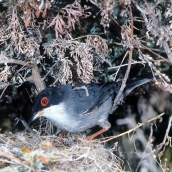Sardinian Warbler (Sylvia melanocephala)
This little warbler measures 13-14 cm in length. Sexual dimorphism is rather pronounced, as the male has a black head, dark grey back and belly, although the throat and rump are white. The female has a greyish head, light brown back and belly, and a white throat. Both sexes have red eyes, but the male’s are darker, a clearly distinguishing feature. This bird breeds in the Canary Islands, where it is found throughout, except on the islets, although it has been observed on La Graciosa during the migratory season. Isolated sightings have been reported for Madeira and Cape Verde, though there is reasonable doubt about their validity in the case of Madeira. The subspecies S. m. leucogastra, present in the Canaries, is not genetically distinct from continental birds but is darker. It is found in a variety of habitats, always with some tree cover, including lowland Euphorbia communities, thermophile forest strongholds, low-lying areas of fayal-brezal firetree and heath, cultivated land and, albeit marginally, high montane scrub, up to 2,000 m. In Gran Canaria and Fuerteventura in particular it favours clumps of tamarisks (Tamarix spp.). It feeds on fruits and invertebrates, thereby contributing to the pollination of plants endemic to the Canaries, such as Isoplexis canariensis and Canarina canariensis. A clutch of 2-4 eggs is laid in up to two broods a year and the breeding season occurs from February to July. The nest is cup-shaped, quite broad and circular, has cobwebs around the edges and no inner lining. It is located in shrubs and small trees, from 0.2-5 m off the ground, but not normally above 2 m. This species is very common and widespread throughout the Canaries (except on Lanzarote and Fuerteventura) and is not considered under threat.













